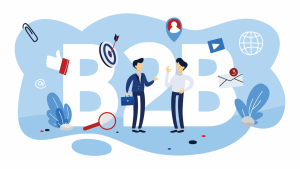A Brief Overview of B2B Multitouch Attribution Model Types
In multisensory attribution, each touchpoint interacts with the customer before converting—the difference is in the number of credits assigned to each touchpoint. These models can either be used as is or modified to create custom models.
Linear multi-sensory attribution model
When you use a linear attribution model, each touchpoint in the buyer’s journey receives the same amount of promotional credit. While this type of attribution takes into account all the touchpoints along the buyer’s journey, it weighs each one equally.
While linear attribution improves first or last touch attribution, it still leaves a lot to be desired because not all touchpoints impact consumers equally.
U-shaped multi-touch attribution model

According to the U-shaped multisensory attribution strategy, 40% of the value is attributed to the first and last contact, and 20% is attributed to subsequent touchpoints.
This gives your team a clear idea of where the customer journey begins and where it ends.
Because this attribution model considers that not all touchpoints are the same, it is more reflective of how marketers value touchpoints inherently.
This is because it gives weight to the start and end campaigns.
However, it does not meet all the travel requirements of the client due to its simplistic point of view.
Multi-sensory attribution Time Decay
This model focuses more on customer touchpoints that are closer to the conversion.
Even though some touchpoints are at the top and middle of the funnel, this article focuses on touchpoints at the end of the marketing funnel.
The temporal decay model emphasizes touchpoints that directly lead to conversions and ignores awareness-based touchpoints.
While conversions are critical to making your business profitable, downplaying the first touch point isn’t right for all marketing teams.
W-shaped multi-touch attribution model
The W-shaped model is responsible for assigning 30% value to the first touch, intermediate (lead generation) and final (conversion) touchpoints.
The remaining 10% is equally distributed among additional obligations.
This model is ideal when there is a well-defined “opportunity creation” phase in the journey.
While this is a significant improvement over the one-or-nothing approach, it’s not always the best model for marketing teams to accurately attribute conversions.
Full path multi-sensory attribution model
This model, commonly used in B2B spaces, is quite detailed and complex.
Similar to the W-shaped multi-sensory attribution, the touch point is added here for lead generation.
This marks the moment when a marketing lead becomes a qualified lead.
Here, 22.5% of the credit goes to the first touchpoint and lead generation, opportunity creation, and sales touchpoint, with the remaining 10% distributed across the remaining touchpoints.
This is useful because it gives a detailed view of the customer’s journey from start to finish.
So detailed, in fact, that it might not be the best choice for B2C companies or low-engagement shoppers.
Custom multi-sensory attribution model

The company itself is developing this model.
This allows marketers to base the value of each touchpoint on their own parameters.
This is ideal for those who want to get the most out of multiple models.
It can be difficult to pull together all the benefits of individual attribution.
You may need to invest in attribution modeling software and experts to properly tailor your attribution strategy.
